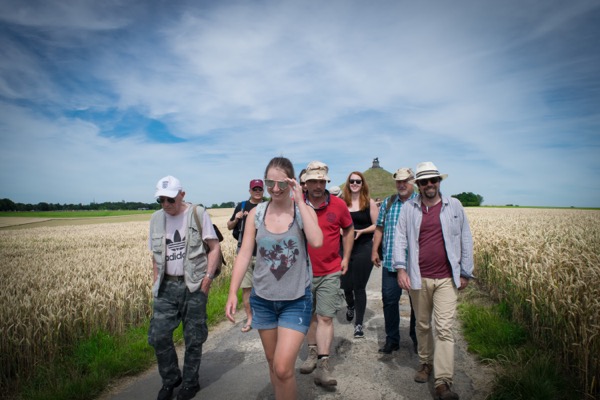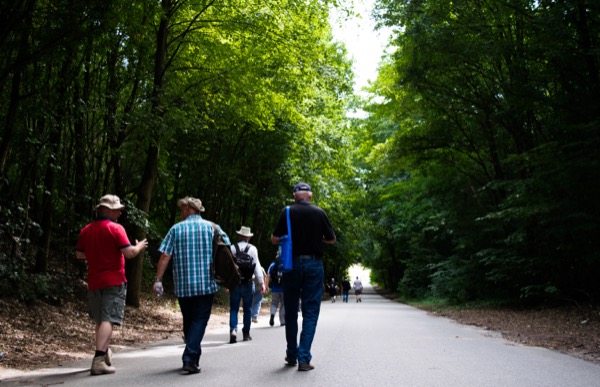
Sunday was the first official day of Waterloo Uncovered 2017!
After a long journey for many of our team members (many arriving en masse by mini van on Saturday evening), everyone settled in and finally got to meet each other properly: a merry mix of veterans, archaeologists, students, scholars, locals, detectorists, film makers and photographers. This year is a year of firsts at WU, as we have been expanding our already international team, with archaeologists from the States and also veterans from the Netherlands and (for a few days!) from France.
Sunday kicked off with a briefing from Mark (WU’s CEO), setting out the order of the day and handing out the standard issue Waterloo Uncovered t-shirts and boots. Then Prof Tony Pollard (our archaeological director, University of Glasgow) gave a 101 of the Battle of Waterloo, the “Battle within a Battle” for Hougoumont, and got the team up-to-speed on all of our discoveries to date on site since our first ‘ excavation campaign’ in 2015. If you would like to find out about our results for yourselves, look back on our dig diaries from previous years here, or here for all of our in-depth reports for all you swots out there!
It is one thing to be told about the battle or to look at paintings and pictures. But the best way to really understand the circumstances of that fateful day on the 18th June 1815, is to get out there in the landscape and to see it for yourself. So, for the afternoon the whole team bussed out to tour the battlefield.

Prof Tony Pollard, leading the way along the ridge.

The Lion’s Mound
Starting at the Mont du Lion, Tony led the group up the winding walk along the ridge at Mont Saint Jean, giving a play-by-play of events. A key stop included the location where Wellington’s troops had famously stationed his troops behind the ridge – hidden from view of Napoleon’s ‘Grande Batterie’ of field cannons. It was also here where the Anglo-Allied forces famously ‘held square’ against Field Marshal Ney’s relentless cavalry charge.
James, a serving soldier of the Irish Guards said:
“This is the part that I most enjoyed – looking at the land and looking at the tactics from the point of view of being a modern soldier. It was interesting to hear about tactics that are still used today. Wellington was using the ‘dead ground’ here – a term that we use all the time – to deceive Napoleon, as he wouldn’t have been able to see what was going on behind the slope and direct his attack properly.
Obviously we’ve moved on a bit in modern warfare (a drone would have spotted them in no time!), but I thought that was quite smart on Wellington’s part”.
Finally, the team arrived at Hougoumont, the location of our archaeological investigations and our ‘basecamp’ for the next two weeks. Hougoumont was the first place to be attacked in the battle, starting at 11am with an offensive led by Napoleon’s contentious brother Prince Jérôme. We arrived first at the North Gate, the site where the French made a breakthrough into the courtyard, and a desperate fight to secure the interior played out.



Tony showed the team around the site, describing how the battle for Hougoumont progressed with bloody results at the ‘Killing Ground’, showing the group where the French cannons were brought up to fire on the Chateau, and finally entering into the chateau complex to explore the formal gardens and interior, which stood for many years in ruins but recently restored to glory by Project Hougoumont.
With brains fit to burst and legs well worn out, the team headed home for a well earned drink, filled with excitement for Monday – the first day of digging!!
Follow our updates on social media: Facebook Twitter Instagram

Last stop – Hougoumont!


Only one of the three sweet chestnut trees, that was standing at the time of the battle is still living. All three are filled with holes from musket shot.